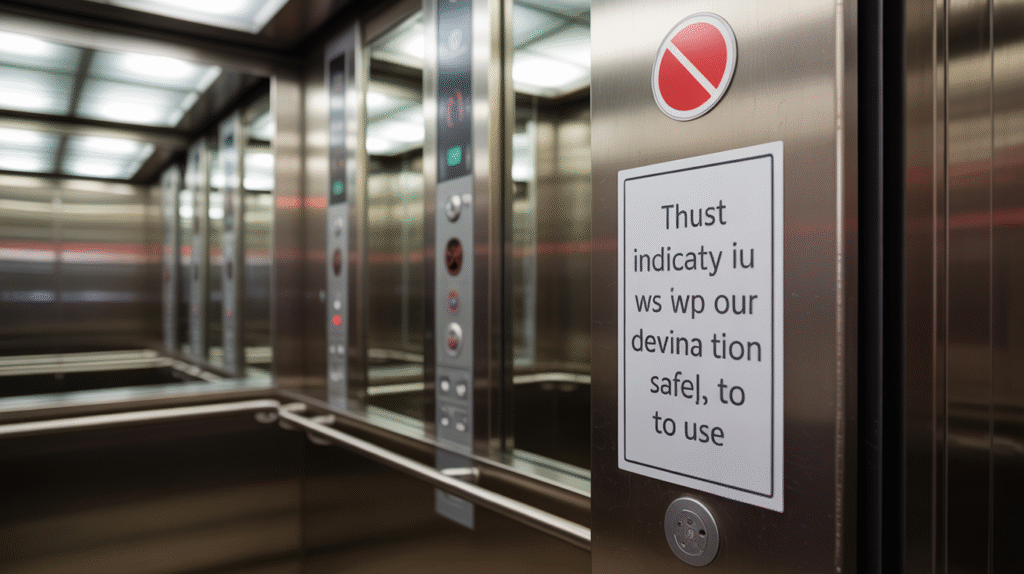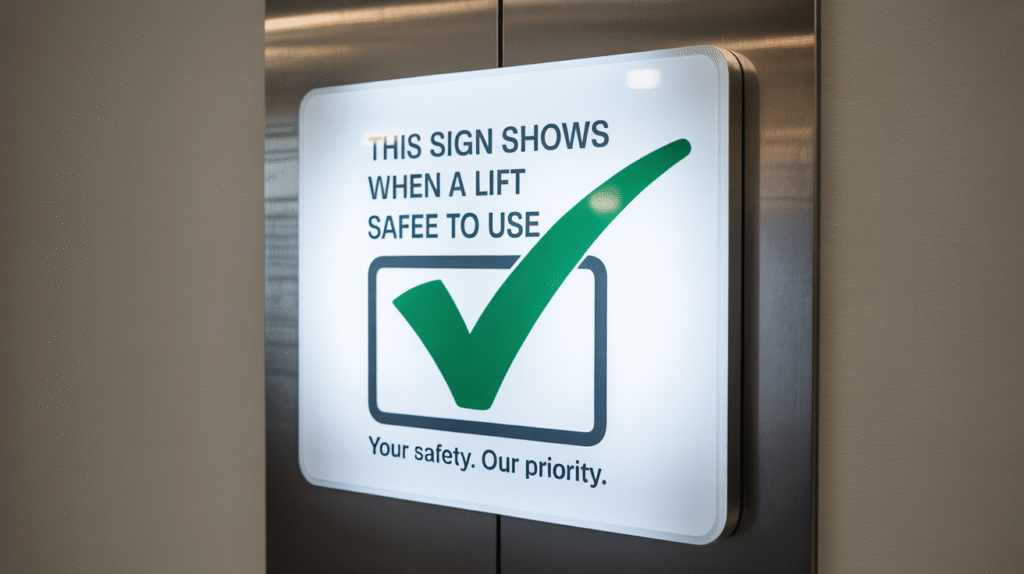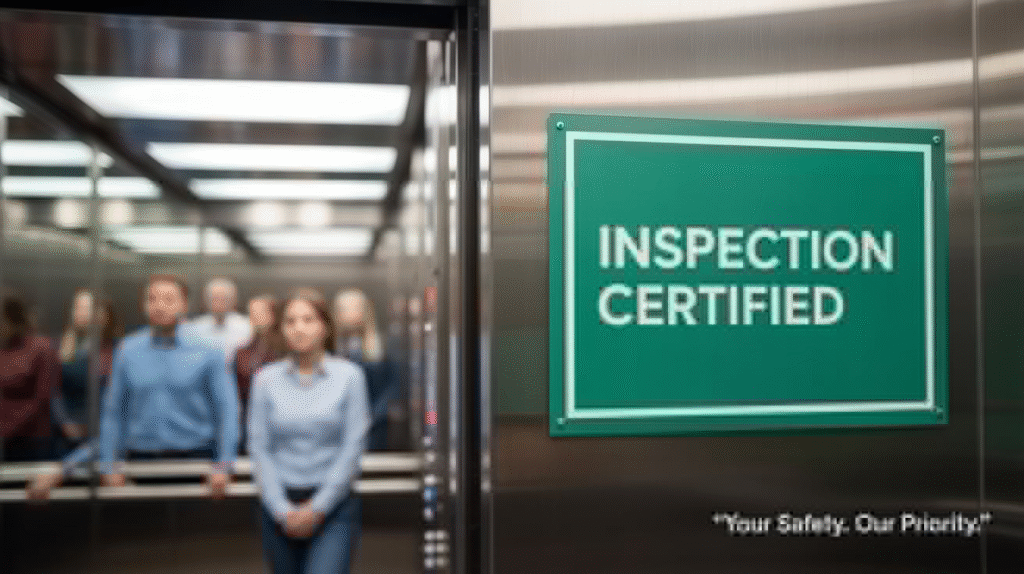Every time we step into an elevator, we’re putting our trust in the system—trust that it will lift us to our destination safely. But how do you know it’s really safe? The answer lies in one simple but vital clue:
This indicator indicates when using a lift is safe.
That small sign posted inside or near a lift is more than a routine document—it’s your assurance of safety, maintenance, and certification. Whether you’re in a shopping mall, office tower, or residential apartment, this sign tells you if the lift has passed its latest inspection, meets the legal safety standards, and is currently certified for use.
Table of Contents
What Is the “Lift Safety Sign”?

The lift safety sign is a legal document or certificate displayed near the lift controls or cabin wall. It indicates:
- The date of the last safety inspection
- When the next inspection is due
- The agency or technician who certified the lift
- The maximum load capacity
- Emergency contact details
This sign confirms the elevator complies with local building safety regulations and can safely carry passengers.
Why Is This Sign So Important?
Ignoring this sign can mean stepping into an unsafe elevator—one that could be overdue for maintenance, malfunctioning, or even illegal to operate.
The lift safety sign ensures:
- The elevator is not overloaded or structurally compromised
- The emergency systems (alarms, brakes) are functional
- The elevator’s electrical systems are up to code
- You are protected by legally enforced maintenance protocols
In many countries, not displaying this sign is a violation of public safety laws.
Real Example: What This Sign Looks Like

Look around next time you’re in a lift. You’ll likely find:
- A laminated paper or metal plate
- Stamped by an inspection authority
- A load capacity (e.g., “Max Load: 1000kg or 13 persons”)
- Last inspection date and next due date
- Sometimes a QR code to verify online
Some even feature warning icons or safety certifications from companies like Otis, Schindler, or KONE.
What If You Don’t See This Sign?

If you don’t see a safety sign inside the elevator:
- Avoid using it—especially if the building looks poorly maintained.
- Report it to the building’s manager or facilities department.
- Look for another lift or take the stairs if you’re unsure.
No visible certification? That’s a red flag.
Because this sign shows when a lift is safe to use—and if it’s missing, you’re left guessing.
Legal Requirements Around Lift Safety Signs
Different countries have different regulations for elevator safety and signage. However, most regions require that:
- Lifts be inspected every 6–12 months
- A visible sign or certificate is posted for public awareness
- Emergency contacts and usage instructions are present
Example Requirements by Region:
| Country | Legal Inspection Interval | Sign Display Required |
|---|---|---|
| USA | Every 12 months (OSHA) | Yes |
| UK | Every 6 months (LOLER) | Yes |
| India | Monthly in some states | Yes |
| UAE | Bi-annual (Dubai Municipality) | Yes |
How to Read the Lift Safety Sign
The sign will usually contain several technical but readable elements:
- Inspection Agency Name: The licensed company or authority that performed the check.
- Certification Number: For record-keeping.
- Valid Until: The date the inspection is valid.
- Lift Capacity: Number of people or weight limit.
- Emergency Contact Info: To be used in case of breakdown or entrapment.
Key Indicators of a Safe Lift
Use this quick checklist:
Safety sign clearly displayed
No strange noises or jerks
Doors operate smoothly
Emergency button works
Load capacity is visible
No expired dates on the certificate
If even one of these is missing, consider it a warning sign.
A Personal Experience: The Day I Ignored the Sign
I once visited an older office building that had an elevator, but no safety sign. I was in a hurry and didn’t think twice.
Halfway between the 4th and 5th floor, the lift suddenly stopped. No power. No ventilation. I had no emergency contact to call.
I was trapped for 40 minutes until a guard found me.
Since then, I always check—because this sign shows when a lift is safe to use, and when it’s not there, you’re riding blind.
What the Law Says About Unsafe Lifts
Operating a lift without proper safety certification can lead to:
- Heavy fines
- Legal liability if someone is injured
- Insurance denial in case of claims
- Criminal negligence charges in some regions
For building owners and property managers, it’s not just best practice—it’s a legal necessity to display the sign.
Lift Safety Symbols You Should Know
| Symbol | Meaning |
|---|---|
| ✅ | Certified Safe |
| 🛑 | Out of Order |
| ⚠️ | Use With Caution |
| 🔒 | Locked for Maintenance |
| 📞 | Emergency Contact |
These visual symbols, along with the sign, make it easier to quickly judge lift safety.
Why Building Owners Must Take This Seriously
A functioning lift without certification is like driving without brakes inspected. One failure could cost lives—and lawsuits.
Property managers must:
- Schedule regular inspections
- Display up-to-date safety signs
- Ensure all lifts meet regional compliance standards
- Keep logs of past inspections for audit purposes
Final Thoughts: One Sign Could Save Your Life
So let’s recap:
This indicator indicates when using a lift is safe.
- Unexpected breakdowns
- Mechanical failures
- Risk of injury or entrapment
Make it a habit to glance at that safety certificate every time you step into a lift. It’s small. It’s silent. But it speaks volumes.
FAQs
What does the lift safety sign mean?
It shows the lift has passed a recent inspection and is safe to use. It includes dates, load limits, and who approved it.
Where is the lift safety sign usually located?
Inside the lift, near the control panel, or on the wall near the entrance. It should be clearly visible.
What if the sign is missing or expired?
Avoid using the lift and report it to building management. An expired or missing sign means it may not be safe.
How often are lifts inspected?
Typically every 6 to 12 months, depending on local laws. High-traffic buildings may need more frequent checks.
Who is responsible for putting up the sign?
Building owners or property managers are legally required to inspect the lift and display a valid safety sign.
Is it illegal to use a lift without a safety sign?
In many countries, yes. Using or operating an uncertified lift can lead to fines or legal action.
Can I trust a lift just because it looks new?
No. Even new lifts need inspection. Always check the safety sign—it’s the only proof it’s certified safe.



